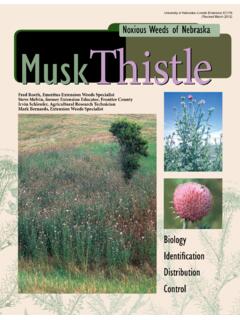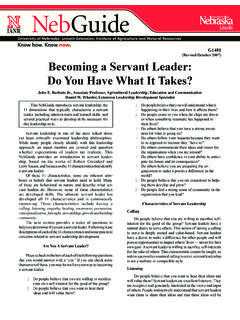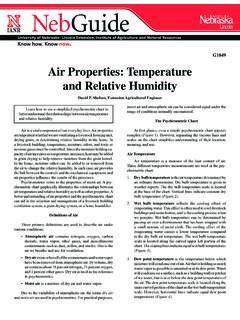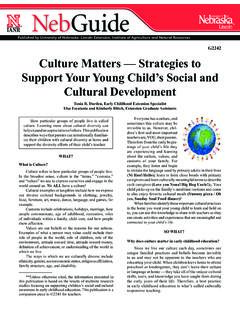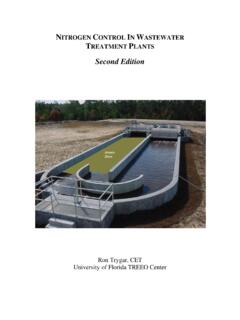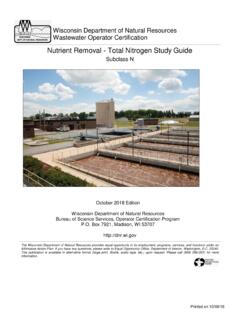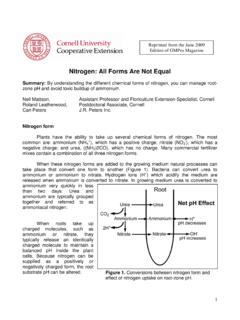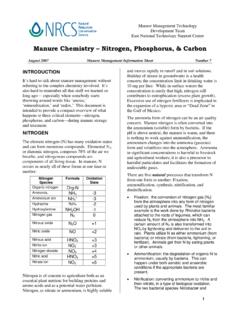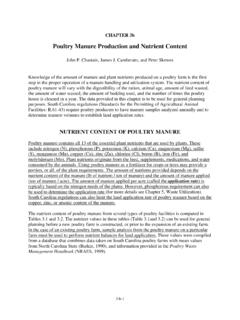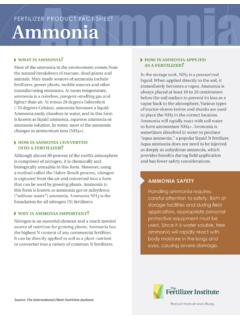Transcription of Nutrient Management Suggestions for Corn
1 EC117. April 2019. Nutrient Management Suggestions for corn Charles A. Shapiro, Emeritus Professor of Agronomy and Horticulture;. Richard B. Ferguson, Charles S. Wortmann, and Bijesh Maharjan, Extension Soils Specialists; Brian Krienke, Extension Soils Educator Fertilizer Nutrient requirements for corn are based on ex- will provide the most accurate recommendations, but a min- pected yield and soil Nutrient availability. The preplant nitrogen imum sample depth of 2 ft is acceptable. To determine P, po- (N) recommendation equation, with adjustment for fertilizer tassium (K) and micronutrient needs, and soil organic matter cost and time of application, is retained from the previous content, collect soil samples from a depth of 0 to 8 inches edition of this publication.
2 Suggestions for in- season nitrogen every three to five years in the fall (http://extensionpubs. decisions are briefly outlined. The major change is providing a phosphorus (P) recommendation based on yield history with sampling/). Most Nebraska soils supply adequate amounts an implied intent to build and maintain soil test P above the of potassium, sulfur, zinc, and iron, but on some soils, the critical level, which has not changed. corn crop will benefit from applying one or more of these nutrients. Calcium, magnesium, boron, chlorine, copper, Nutrient Needs manganese, and molybdenum are seldom, if ever, deficient for corn production in Nebraska and toxicities may occur Crop production in Nebraska typically requires nitrogen with overapplication.
3 The complete University of Nebraska . (N) fertilization to supplement what is available from the Lincoln Nutrient recommendations for all crops are available soil. After N, phosphorus (P) is the Nutrient most likely to at be deficient for profitable corn production. Criteria for other Nutrient - Management -for-agronomic-crops- in-nebraska/. nutrients are given, but the need varies across the state. With overall improved Management by corn producers and up- to- date Nutrient Management information at https:// . in Nebraska, the likelihood of significant levels of residual cropwatch.
4 Unl .edu /tags / Nutrient - Management . nitrate in fields has declined. While deep sampling to account for residual nitrate in fields is still encouraged as a way to nitrogen Requirement fine- tune N fertilizer recommendations, the contribution of residual nitrate to the subsequent crop, or as a risk to ground- Our recommendations for fertilizer N are based on ex- water quality, has declined from what was more common pected yield, the amount of residual soil nitrate- N (NO3- N), in the 1980s and 1990s. This is especially the case for corn - soil organic matter, other N sources, timing of application, soybean rotation systems.
5 We encourage deep sampling for and price of fertilizer. This remains an option and is useful nitrate in circumstances where elevated nitrate is expected. in planning and financial budgeting. Alternative N manage- Such situations might include recent manure applications, ment is suggested for improved fertilizer use efficiency and to large fall or late season fertilization and subsequent above maintain or increase profit. These written guidelines are com- normal precipitation, drought damage, hail damage, and plemented by a downloadable Excel spreadsheet for N rate compromised crops due to pests or other mishaps.
6 Calculation (https:// cropwatch .unl .edu /soils /software). Look Soil nitrate sampling generally is not needed for corn for the corn nitrogen Recommendations Calculator. The N. grown after soybean or other legume unless the fields have recommendation equation has proven to be very accurate for a recent manure history. Sampling to 4 ft for residual nitrate profit maximization on average, but the economic optimum The Board of Regents of the University of Nebraska. All rights reserved. 1. N rate varies by year and application of about 60 percent of the fertilizer N in- season in response to crop needs should be considered (see section on N timing).
7 The N recommendation for corn grain (lb/ac) =. [35 + ( EY) (8 NO3- N ppm) ( EY . OM) other N credits] Priceadj Timingadj where: EY = expected yield (bu/ac). NO3- N ppm = average nitrate- N concentration in the root zone (2 4 foot depth) in parts per million Figure 1. Price adjustment factor based on the corn Price in dol- lars, $/ nitrogen (lb of actual N in $). OM = percent soil organic matter (with a minimum of Note: Adjustment factor for situations where corn : N price ratio is and a 3 percent maximum) between 4 and 12. Other N credits include N from previous legume crop, Price adjustment factor = + ( * corn :N) ( *.)
8 Manure and other organic material applied, and ( corn :N)2). irrigation water N. Example corn price ratio: when corn is $ and nitrogen is $ lb N = 3 = 6. Priceadj = adjustment factor for prices of corn and N. Timingadj = adjustment factor for fall, spring, and split applications uations. Most often, the ratio is around 8:1. Priceadj is applied The expected yield should be about 105 percent of the five- after the other calculations are made. The previously men- year yield average (see NebGuide G481 Setting a Realistic tioned spreadsheet https:// cropwatch.
9 Unl .edu /soils /software Yield Goal). A higher yield goal may be appropriate if man- provides these calculations, with supporting documentation. agement improvements are expected to result in increased yield. The N recommendation equation for corn silage (lb/ac) =. nitrogen Adjustment for Soil Nitrate- N. [35 + ( EYs) (8 NO3- N ppm) ( EYs corn will use soil nitrate- N remaining in the rooting OM) other N credits] Priceadj Timingadj zone from the previous year. This residual nitrate- N should be credited in calculation of N rates. The average nitrate- N.
10 Where: EYS = expected silage yield in t/ac and NO3- N, OM, concentration (in parts per million: ppm) in the root zone N credits, and adjustment factors are the same as those listed (or the depth- weighted concentration) is considered in the above. university's N recommendation equation and is averaged Optimal N rates are sensitive to wide fluctuations in across several soil depths. Soil nitrate- N can be estimated by fertilizer and corn prices. Research conducted from 2002 sampling soil with a single 0 2 foot sample. A default value to 2004 provides the basis for economic adjustments to the for the 2 foot depth of ppm is suggested for medium and N recommendation equation, and is summarized in papers fine textured soils and ppm for sandy soils.
